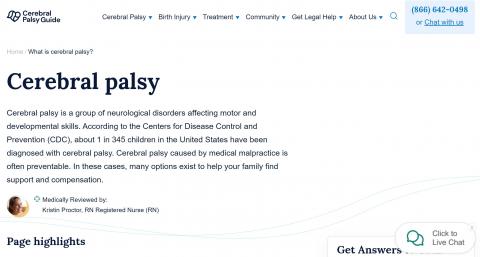Cerebral Palsy Guide
Cerebral Palsy Guide is an organization dedicated to educating individuals and families about Cerebral Palsy. Cerebral Palsy is a neurological disorder affecting motor and developmental skills. Our goal is to help families use any methods we can to make sure their children receive the support they need.
Cerebral palsy
Cerebral palsy is a group of neurological disorders affecting motor and developmental skills. According to the Centers for Disease Control and Prevention (CDC), about 1 in 345 children in the United States have been diagnosed with cerebral palsy. Cerebral palsy caused by medical malpractice is often preventable. In these cases, many options exist to help your family find support and compensation.
What is cerebral palsy?
Cerebral palsy is a group of disorders that affect normal movement in different parts of the body. This condition can cause problems with posture, manner of walking (gait), muscle tone, and coordination of movement.
The word “cerebral” refers to the brain’s cerebrum, which is the part of the brain that regulates motor function. “Palsy” describes the paralysis of voluntary movement in certain parts of the body.
There are several types of cerebral palsy that are characterized by the location of the brain injury. Symptoms can vary depending on where and how badly the brain was damaged.
The types of cerebral palsy include:
Ataxic cerebral palsy: This type is caused by cerebellum damage resulting in issues with motor control and movement.
Athetoid/dyskinetic cerebral palsy: Caused by basal ganglia and/or cerebellum damage; symptoms include fluctuating muscle tone and involuntary movements.
Hypotonic cerebral palsy: This rare type, also caused by cerebellum damage, is characterized by floppy muscles, excess flexibility, and poor mobility.
Spastic cerebral palsy: The most common type of cerebral palsy, caused by damage to the motor cortex or pyramidal tracts and characterized by tight muscles and jerking movements.
Mixed cerebral palsy: Multiple areas of brain damage can cause patients to have more than one type of cerebral palsy.
Depending on how the condition is managed, motor skills can improve or worsen over time. While symptoms and severity vary from case to case, there are many medical and support options to help children with cerebral palsy lead fulfilling lives.


Add New Review